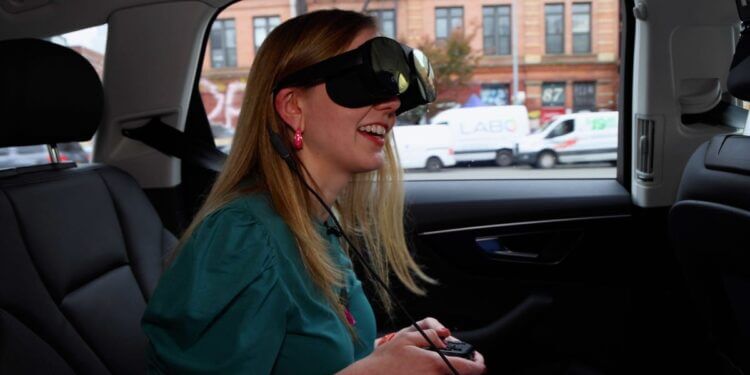Playing VR games in the back seat of a moving car sounds like a motion-sickness disaster. And yet, Holoride has found a way to make it work and is now selling its first VR entertainment packages to customers in Germany, with expansion to the US market planned for early next year.
I had a chance to take the program for a spin last week in New York. Sitting in the back seat of an Audi SUV, I wore an HTC Vive Flow headset as the team from Holoride picked me up from my Manhattan office and drove me around the East Village neighborhood for about 20 minutes.
The demo was for a game called Cloudbreaker, where I was transported into a battleground in the sky to fire at enemy spaceships, passing by tall buildings that look like ancient ruins poking out of the clouds. The headset was Bluetooth connected to the car, with the game gathering data in real-time about the vehicle’s acceleration, braking, steering, and GPS location — all so the virtual world could match how the car was moving.
So when the driver turned, my ship turned. And it was synced in a way that, thankfully, meant my stomach didn’t turn.
You can see my reactions and how it all works in the video embedded above. As someone who gets easily motion sick whenever I glance at my phone in a taxi, the game didn’t feel bad — then again, my game demo wasn’t very long. It reminded me of a theme park motion simulator, where the on-screen action would match every move of my vehicle.
It was most comfortable if I just looked forward most of the time. If I looked left when my driver turned right, that would take me to a queasy town.
The Holoride team also gave me a demo of a feature that lets you watch Netflix or YouTube videos in the headset, with a movie screen just sort of floating in a VR landscape that matched the movement of the car. But that was a no-go for me — it quickly triggered bad feelings so I took off the headset. I wasn’t digging watching the video. Get me back to the games.
Chloride is based in Germany and is a spinoff of Audi. The first Holoride demo was revealed at the 2019 CES tech trade show in Las Vegas. The company has launched some early experiences to test this with the general public, including working with Universal CityWalk in Hollywood to take guests on a ride with the Bride of Frankenstein to find her love. But today is the first time Holoride’s tech is being sold directly to the public so they can experience it anywhere they roam.
Holoride CEO and co-founder Nils Wollny spoke with me about how the software does more than just match turning left and right. The VR world loads differently depending on where you’re located, matching your actual landscape. A mountain in the game may be a building in real life. And a dip in the landscape may be a place where the driver could potentially turn.
The Holoride experience is currently being sold as a packaged deal. For 699 euros in Germany (and Wollny says it should be similarly priced for the US, costing $699 at launch next year), you get the HTC Vive Flow VR headset, an 8BitDo Pro 2 game controller, and a one-year subscription to the Chloride platform of software and games — and at the start, it’s only compatible with newer Audi cars.
It remains to be seen how large that library of content will be after that first year when Holoride plans to charge a $20 monthly subscription to access its content. The company says the price will be if you pay for the whole year upfront.
It’s worth noting that even if the Holoride content doesn’t take off, the Vive Flow headset and game controller that comes in the package will still work like any VR headset. It’s not locked in the car.
Holoride will have to build the concept into Holoride software for it to work on multiple types of headsets and be compatible with multiple car systems. Could we soon hear about it working with other types of cars? CEO Wollny said we can expect more Holoride news to be revealed in January at CES 2023.





